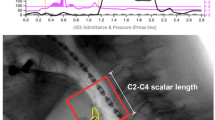Abstract
Tongue base pressures have been thought to provide primary bolus clearance through the pharynx during swallowing. The relationship between bolus driving pressures and residue remaining in the valleculae after the swallow has not been defined. Thirty-seven dysphagic patients who were evaluated with both videofluoroscopy (VFSS) and high-resolution manometry (HRM) were identified within the University of Wisconsin Voice and Swallowing Outcomes database. Patients were categorized according to binary ratings of presence or absence of vallecular stasis as well as incomplete or complete tongue retraction on VFSS. Tongue base region pressures measured with HRM during saline swallows of 1 and 10 ml volumes were compared to ratings of vallecular stasis or tongue base retraction. No significant difference could be identified among mean peak HRM pressures when compared to presence or absence of vallecular stasis (1 ml saline: p = .1886; 10 ml saline: p = .7354). When categorized according to complete or incomplete tongue retraction, mean peak HRM pressures were significantly greater in the complete tongue retraction group as compared to incomplete tongue retraction (1 ml saline: p = .0223; 10 ml saline: p = .0100). Findings suggest there are multiple factors that lead to reduced vallecular clearance. In the absence of HRM measures, judging complete or incomplete tongue retraction on VFSS may be a more valid gauge of tongue base region pressures than vallecular clearance when planning dysphagia treatment.
Similar content being viewed by others
References
McConnell FMS, Cerenko D, Jackson RT, Guffin TN. Timing of major events of pharyngeal swallowing. Arch Otolaryngol Head Neck Surg. 1988;114:1413–8.
Pouderoux P, Kahrilas PJ. Deglutitive tongue force modulation by volition, volume and viscosity in humans. Gastroenterology. 1995;108:1418–26.
Hoffman MR, Ciucci MR, Mielens JD, et al. Pharyngeal swallow adaptations to bolus volume measured with high-resolution manometry. Laryngoscope. 2010;120:2367–734.
Palmer JB, Tanaka E, Siebens A. Motions of the posterior pharyngeal wall in swallowing. Laryngoscope. 1988;98:414–7.
Kahrilas PJ, Logemann JA, Lin S, Ergun GA. Pharyngeal clearance during swallowing: a combined manometric and videofluoroscopic study. Gastroenterology. 1992;103:128–36.
Perlman AL, Grayhack JP, Booth BM. The relationship of vallecular residue to oral involvement, reduced hyoid elevation, and epiglottic function. J Speech Hear Res. 1992;35:734–41.
Dejaeger E, Pelemans W, Ponette E, Joosten E. Mechanisms involved in postdeglutition retention in the elderly. Dysphagia. 1997;12:63–7.
Dodds WJ, Stewart ET, Logemann JA. Physiology and radiology of the normal oral and pharyngeal phases of swallowing. Am J Roentgenol. 1990;154:953–63.
Pauloski BR, Rademaker AW, Lazarus C, Boeckxstaens G, Kahrilas PJ, Logemann JA. Relationship between manometric and videofluoroscopic measures of swallow function in healthly adults and patients treated for head and neck cancer with various modalities. Dysphagia. 2009;24:196–203.
Perlman AL, Booth BM, Grayhack JP. Videofluoroscopic predictors of aspiration in patients with oropharyngeal dysphagia. Dysphagia. 1994;9:90–5.
Molfenter SM, Steele CM. The relationship between residue and aspiration on the subsequent swallow: an application of the normalized residue ratio scale. Dysphagia. 2013;28:494–500.
Kuhlemeier KV, Yates P, Palmer JB. Intra- and interrater variation in the evaluation of videofluorographic swallowing studies. Dysphagia. 1998;13:142–7.
Scott AS, Perry A, Bench J. A study of interrater reliability when using videofluoroscopy as an assessment of swallowing. Dysphagia. 1998;13:223–7.
McCullough GH, Wertz RT, Rosenbeck JC, Mills RH, Webb WG, Ross KB. Inter- and intrajudge reliability for videofluoroscopic swallowing evaluation measures. Dysphagia. 2001;16:110–8.
Bryant KN, Finnegan E. VFS interjudge reliability using a free and directed search. Dysphagia. 2011;27:53–63.
Knigge MA, Thibeault S, McCulloch TM. Implementation of high-resolution manometry in the clinical practice of speech language pathology. Dysphagia. 2014;29:2–16.
Rosenbek JC, Robbins JA, Roecker EB, Coyle JL, Wood JL. A penetration-aspiration scale. Dysphagia. 1996;11:93–8.
Veis S, Logemann JA, Colangelo L. Effects of three techniques on maximum posterior movement of the tongue base. Dysphagia. 2000;15:142–5.
Stoeckli SJ, Huisman TAGM, Seifert B, Martin-Harris BJW. Interrater reliability of videofluoroscopic swallow evaluation. Dysphagia. 2003;18:53–7.
Acknowledgments
The authors would like to thank Glen Leverson, PhD for his statistical assistance
Funding
This work was funded by the Diane M. Bless Endowed Chair.
Author information
Authors and Affiliations
Corresponding author
Ethics declarations
Conflict of interest
The authors declare that they have no conflict of interest.
Rights and permissions
About this article
Cite this article
Knigge, M.A., Thibeault, S. Relationship Between Tongue Base Region Pressures and Vallecular Clearance. Dysphagia 31, 391–397 (2016). https://doi.org/10.1007/s00455-015-9688-0
Received:
Accepted:
Published:
Issue Date:
DOI: https://doi.org/10.1007/s00455-015-9688-0




